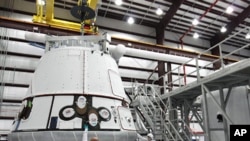A private company called SpaceX plans to attempt something that has only been accomplished by governments - sending a spacecraft up to the International Space Station, or ISS. But SpaceX issued a statement Wednesday saying the May 7 launch to the ISS had to be postponed, adding that SpaceX is "continuing to work through the software assurance process with NASA." A new launch date has yet to be set.
If all goes according to plan, SpaceX's Falcon 9 rocket carrying its unmanned Dragon capsule will lift off from Cape Canaveral in Florida. Then, the cargo-carrying spacecraft will journey toward the International Space Station, where it will dock, if all goes well.
It is the first time a private company will attempt such a mission.
This demonstration launch had been targeted for November 2011, then rescheduled multiple times this year.
Elon Musk, the chief executive officer at SpaceX, said at a NASA news briefing last month that many things can go wrong with such complex, relatively new technologies.
He said the biggest challenges have been related to Dragon's planned proximity and berthing operations with the space station, and he said software testing has been the main cause of delays.
"Does the software always do the right thing in a particular circumstance? And when you've got 18 engines and you've got six flight computers and a whole bunch of other systems, the test matrix of that is enormous," said Musk.
Musk said the Falcon 9 rocket, which has been tested twice, is not the issue. Nor are the elements of the Dragon spacecraft that were tested during its orbital mission in 2010, such as its thrusters, heat shield and parachutes.
He emphasized that Dragon is an autonomous, robotic spaceship and that berthing with the space station is a complicated maneuver.
"It's not as though there is somebody flying it with a joystick or that there is somebody on board who can make real-time corrections," he said. "Dragon is making lots of decisions all the time to optimize the probability of success, so there's a lot of intelligence on board the spacecraft and all of that has to be tested thoroughly, and that's the biggest driver of the timeline."
SpaceX made history when it successfully tested its Falcon 9 rocket and Dragon capsule in December 2010. It is the only commercial company to re-enter a spacecraft from Earth orbit. But the next step is for the reusable Dragon to make it to the space station, which is zooming around the Earth every 90 minutes.
The station is well stocked, so there are no concerns if the astronauts do not get the cargo on this demonstration flight.
To date, NASA has invested $381 million in SpaceX's commercial cargo capabilities. The U.S. space agency is investing in commercial companies to handle low-Earth orbit transportation so NASA can focus on the next generation of spacecraft that can go deeper into space.
News
Commercial Launch to ISS Delayed Again






